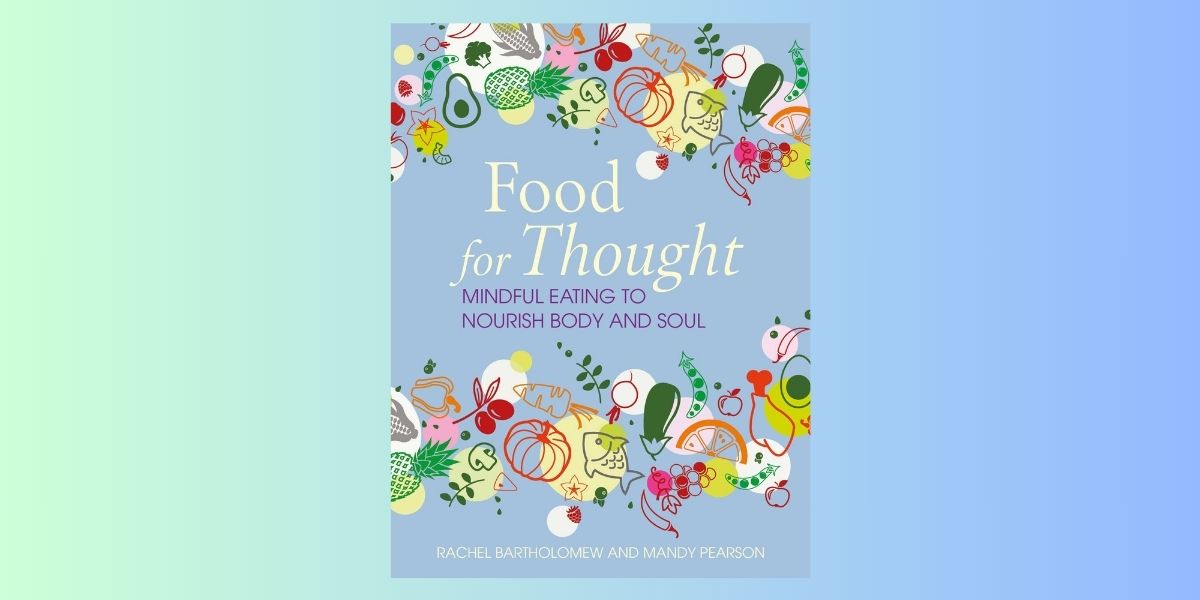
Food for Thought: Mindful Eating to Nourish Body and Soul, by Rachel Bartholomew and Mandy Pearson
CICO Books, 978-1800653221, 160 pages, April 2024
Recently, I’ve been seeking to change my relationship with food. Instead of jumping into a new food trend or committing to a diet that doesn’t feel maintainable, my focus has been on cultivating new habits by making one little change at a time. Food for Thought: Mindful Eating to Nourish Body and Soul by Rachel Bartholomew and Mandy Pearson has a motivating source of supportive on my journey to changing my eating patterns.
“You may be ready to give your eating habits a complete overhaul straight away, or you may decide to just change one thing to start with. Do tell yourself that whatever you can do right now is right for you in this time and place, and is absolutely worth it.”1
Food for Thought serves as a comprehensive guide to transforming one’s relationship with food through the practice of mindful eating, delving into the philosophy that eating is not just a physical act of nourishment but also an emotional and spiritual experience that can lead to improved health and well-being when done mindfully. The authors, Bartholomew and Pearson, combine their expertise in nutrition and mindfulness to present a harmonious approach to eating. They teach readers that by being fully present during meals, we can achieve a deeper appreciation for the flavors, textures, and overall experience of eating, which can lead to better digestion, reduced overeating, and a more satisfying relationship with food.
This book is filled with practical exercises, thoughtful insights, and easy-to-follow advice aimed at helping readers slow down, savor each bite, and reconnect with their food in a more meaningful way. There’s also plenty of delicious recipes throughout the book, such as a carrot and lentil dip, spiced oatmeal cake with cinnamon and chocolate frosting, falafel with minted yogurt, and slow-cooked lamb salad.
Plus, the colorful pages and easy-to-understand content, enriched with little graphics, make this book not just a resource but an experience as you move through it. There’s plenty of moments to pause, as the authors have included “Mindful Practices”, encouraging readers to stop and savor not only their meals but also the moment and the sensations that come from integrating this information as they read. These practices are perfect for reflection and create the space to truly deepen your connection with the information being presented.
What I like most about the authors’ approach to eating is how they believe we can intuitively know what our body needs. Instead of going to extremes in our eating or obsessively seeking out new information, we can instead learn to listen to our inner voice, and honor what our body is telling us. They write, “Your instinct will often point you in the right direction if you slow down and make space to connect with this inner wisdom.”2 And I’ve found that taking time in the morning and before bed to read a chapter of Food for Thought or taking time to reflect on what I’ve learned–the important of having a direction, staying organized with my meals, affirming new beliefs–helps me to stay on track with my goals.
The well-rounded content brings a level of mindfulness to food triggers, cravings, and lifestyle factors that influence one’s health and eating habits in a way that feels gentle. These topics can feel very painful to acknowledge, especially if they’ve been unconscious while we eat on autopilot mode. But change requires doing a bit of deeper questioning about the way we are fueling ourselves in order to pick more nourishing options. The authors’ approach is compassionate, caring, and very helpful in a practical way, paving the way for this inner work becomes a practice of self-love.
Bartholomew and Pearson also have taught me that making changes to my eating habits is not just about the act of eating–it’s about reshaping one’s entire approach to food. They emphasize the importance of choosing foods that are nourishing to both the body and the soul, advocating for a diet that is as good for the planet as it is for the individual, helps me be more conscious of where I am sourcing my food from, the time (or lack thereof) that I take to prepare it, and the impact of the speed I consume my food and my attention while doing so.
With its blend of nutritional science and mindful living practices, Food for Thought is a valuable resource for anyone looking to foster a healthier, more conscious approach to eating. Whether you’re a seasoned practitioner of mindfulness or new to the concept, Bartholomew and Pearson’s insights offer a refreshing perspective on how to enrich your life through the simple act of eating. I recommend this book both for those looking to create more conscious eating habits to enhance their overall well-being and those who are seeking to expand their mindfulness practice to include meal time.
Alanna Kali is an astrologer, numerologist, and pioneer spirit that loves to explore life through the lens of depth psychology. She has a passion for studying the humanities and social trends. Her academic work is centered upon reuniting body, mind, and spirit through eco-psychology. She loves reading, spending time in nature, and travel.
